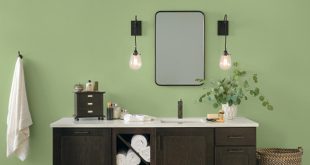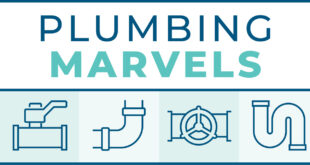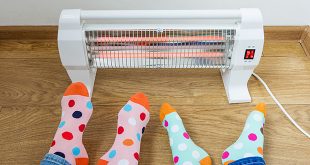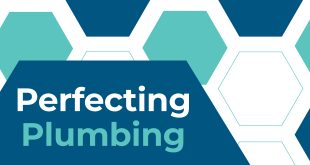Over the last several years, homeowners have been given more options to customize their bathrooms into spaces that rival high-end spas. Changes and improvements in plumbing products have made it easier than ever for DIYers to bring paradise closer to home.
“When it comes to bathroom-related projects, DIYers are doing everything from simpler plumbing fixtures and fitting replacements to full-blown remodeling projects,” says Pete DeMarco, an executive from the International Association of Plumbing and Mechanical Officials (IAPMO Group), a nonprofit that specializes in developing standards for the plumbing industry.
“Consumers are increasingly looking at their bathrooms as places of refuge and relaxation from their busy lives.” Consumers are also more concerned with energy and utility cost savings, whether they are installing solutions themselves or purchasing a home with the upgrades already installed.
Learn more about trends in sustainable plumbing solutions on the following pages and see how you can serve customers looking to create an energy-efficient oasis inside their homes.
Today’s DIYers Have It E-Z
Plumbing Manufacturers International (PMI) is a management trade association that represents companies that sell about 90 percent of all plumbing products across North America. PMI CEO and executive director Kerry Stackpole says, thanks to new technology, there are a lot of exciting developments in both style and sustainability.
Stackpole says when it comes to plumbing upgrades, the average DIYer will most likely be looking to replace a showerhead or a faucet, but you’ll find a few who are looking to put in a toilet, even though those are more often installed by a pro. A lot of this, he says, is due to the innovation coursing through the pipes of plumbing business, for example standardized threads for showerheads.
“You don’t have to sweat a pipe anymore,” he says. “These are projects DIYers can efficiently handle themselves.”
Homebuilders are also taking sustainable products into consideration, Stackpole says, which give occupants of new construction a head start on energy savings.
“Homebuilders understand that people are interested in utilizing natural resources responsibly, so a lot of them are installing WaterSense fixtures,” he says. “WaterSense products are certified by the U.S. EPA to be 20 percent more efficient than regular fixtures, which can lower your utility costs and shrink your footprint in terms of use of natural resources.”
Stackpole says one national building company installs about 600,000 WaterSense products in new homes every year. While some customers might not see energy conservation and water conservation in the same light, Stackpole says it takes gas or electric energy to keep the hot water hot, so the less water used, the less energy it takes.
“WaterSense is a labeling program that is run and managed by the EPA and works in a similar manner to the Energy Star labeling program for products that consume energy,” DeMarco says. “The EPA works with the industry and other stakeholders to develop performance specifications that go beyond the minimum product standards in order to deliver great performance as well as water and energy efficiency to consumers.”
Efficient Yet Effective
Changes in water usage standards give you a chance to offer customers significant improvement even over the plumbing of 10 years ago.
“The biggest advancements have been in toilet design and performance,” DeMarco says. “In recent years, manufacturers have been able to apply new product tools, such as computational fluid dynamic (CFD) platforms, that allow them to develop well-performing models.”
DeMarco says new toilets are significantly more efficient with water than older toilets.
“Today’s toilets flush better than older systems that used almost three times as much water,” DeMarco says. “For the most efficient and best performing models, I recommend DIYers look for WaterSense-labeled models. They get the job done in one flush, conserve huge amounts of water and save money.”
 Showerheads also offer consumers an amazing array of options; you can escape the world into a tropical rainstorm, a misty morning or other nature-inspired features just by stepping into the shower.
Showerheads also offer consumers an amazing array of options; you can escape the world into a tropical rainstorm, a misty morning or other nature-inspired features just by stepping into the shower.
Stackpole says these features are some of his favorite plumbing developments.
“They’re designed to use less water, but still deliver the feel of a full shower by engineering the size of the drops of water coming out of the shower head,” he says. “Now we have options like misting or rainwater showerheads that mimic the feel of those conditions. The beauty here is that consumers don’t have just one choice—they have 30,000. There’s a huge number of products out there that help people be efficient.”
DeMarco says handheld showerheads are also an option for consumers looking to save water and energy.
“They’re great, not only for showering, but for easier cleaning of bathtubs and shower compartments and also for bathing pets,” he says. “They deliver the same water efficiency levels that fixed showerheads provide.”
Aside from updating fixtures to more efficient models in an effort to be more environmentally friendly, eliminating paper products and installing reuse systems is another way to go green.
Stackpole says a bidet can significantly reduce or even eliminate the need for toilet paper, and bidet seats that attach to the top of the toilet are becoming increasingly popular. New technology also allows households to install water reuse systems.
“Some homebuilders are making reuse systems available, and they may even be mandated in some areas,” says Stackpole. “These systems reuse water that might normally just drain out of the sink or shower. The water is filtered and recirculated back to use for watering the lawn or washing the car. They’re bound to change the way we think about water usage.”
After the upfront investment, many of these installations will pay for themselves quickly.
Does Your Product Mix Hold Water?
More products than space to put them means you need to be strategic about the selections you have on the salesfloor. Stackpole recommends stocking a cross-section—for example, stock products at the major price points, styles and colors so customers get a good idea of what they can choose from.
“Having both an inexpensive and a high-end faucet helps consumers understand the range of products,” he says. “You can’t stock all of them but knowing what’s available is key.”
According to Stackpole, black is the new chrome, so having this option will alert savvy customers that you’re on trend.
“The advantage independent stores offer is a higher level of knowledge about the products they sell.” —Pete DeMarco, IAPMO Group
If you don’t have space on your salesfloor for every model, clearly communicating your ability to complete special orders is key to making the sale. Through signage and knowledgeable staff members who understand the special-order process, you can serve nearly any customers’ needs.
“Where retail space is at a premium, it’s best that hardware retailers do the research and feature the ‘best in category’ offerings,” Demarco says. “The advantage independent stores offer is a higher level of knowledge about the products they sell and the ability to help DIYers prepare for and try to mitigate common challenges that are encountered with plumbing projects.”
He says customers looking for sustainable products will most likely purchase products made by companies that provide clear information about their commitments to the environment and sustainability in their manufacturing processes, so having signage in your plumbing department showing sustainable options is crucial.
Training employees to answer questions knowledgeably and understand the full scope of projects will help your store stand out.
“An important selling point is that they’ll make fewer trips back to the store to get things that they should have been told they’ll need during the initial purchase,” DeMarco says. “This is where independent stores can really shine.”
Toilet Efficiency
Toilet Efficiency
Before 2006 (Energy Policy Act of 2005)
- 3.5 to 5 gallons per flush (GPF)
Today
- 1.6 GPF maximum
- 1.28 GPF WaterSense-certified
The Fixtures Builders Are Installing
The National Association of Home Builders (NAHB) recently surveyed builders from across the country about their installation of toilets that are more efficient than the federal standard. See the results here and use the data to talk to your pro customers about what options they want and what homeowners are requesting in new builds when it comes to efficient fixtures in the bathroom.
 Hardware Retailing The Industry's Source for Insights and Information
Hardware Retailing The Industry's Source for Insights and Information








